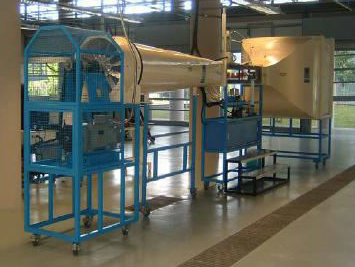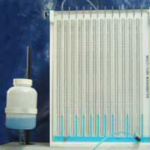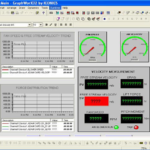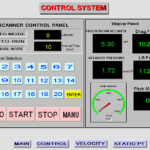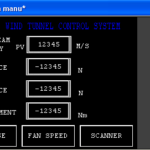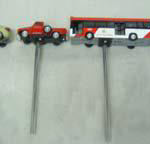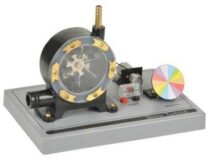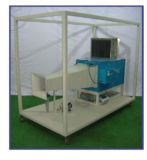OPEN WIND TUNNEL – SUBSONIC FOR RESEARCH MODEL AT 004
Home » Products » OPEN WIND TUNNEL – SUBSONIC FOR RESEARCH MODEL AT 004
OPEN WIND TUNNEL – SUBSONIC FOR RESEARCH MODEL AT 004
Sci-tech Open Wind Tunnel – Subsonic for Research, Model AT 004 is a suction type open circuit wind tunnel designed to conduct teaching and basic research experiments related to fluid mechanics and aerodynamics. All tunnel components are supported on metal frames and include lockable castors for mobility. The wind tunnel components are of metal construction suitably surface treated or painted to avoid corrosion. The combination of bell mouth entry, settling chamber with honey comb and three screens and large nozzle contraction ratio provide tunnel mean flow uniformity and turbulence values required for any basic and applied aerodynamic research. Air filter is provided to ensure dust free air for the use of hot wire anemometry for flow fluctuation measurements. The square test section is designed for easy installation and changing of models, accessories and instrumentation. Transparent glass windows are provided to facilitate optical measurement techniques such as LDV and flow visualization. Diffuser transition is designed to decelerate the flow without flow separation from the walls. The drive system consists of a six-bladed fan and a variable speed motor and controller. Wind tunnel test speeds up to about 60m/s can be obtained. Vibration during tunnel operation is minimized by suitable mounting of the fan drive system. The floor mounted model support system is provided to position models in the test section and conduct tests at various angles of incidence. Model having standard geometrical details such as NACA 0012 symmetric aerofoil sections with surface pressure tapings is provided for comparison with available data in the literature and ensure proper calibration of testing procedure. Tunnel operation, control, ‘Sci-Cal’ data acquisition and processing of data are through an integrated computer based system.
| Size: | 550cm x 1250cm x 1450cm (LxWxH) |
| Weight: | 660 kg |
Item Description
A wind tunnel is a duct through which air is either blown or pulled out to simulate air flow over objects. The model of the object to be tested, called the prototype, is placed in the test section of the wind tunnel and the pressures, forces and moments experienced by the model at various wind speeds and in different orientation with reference to the wind are measured using special transducers. The results of wind tunnel measurements can be utilized to generate the design data for the prototype. Wind tunnels are useful research and educational tools for students to study problems related to several areas including fluid mechanics and aerodynamics. Subsonic wind tunnels are employed for teaching and research in aeronautical, mechanical, automobile, civil, architectural, environmental and marine engineering departments of educational institutions.
The Sci-tech Open Wind Tunnel – Subsonic for Research, Model AT 004is a suction type open circuit wind tunnel designed to conduct teaching and basic research experiments related to fluid mechanics and aerodynamics. All tunnel components are supported on metal frames and include lockable castors for mobility. The wind tunnel components are of metal construction suitably surface treated or painted to avoid corrosion. The combination of bell mouth entry, settling chamber with honey comb and three screens and large nozzle contraction ratio provide tunnel mean flow uniformity and turbulence values required for any basic and applied aerodynamic research. Air filter is provided to ensure dust free air for the use of hot wire anemometry for flow fluctuation measurements. The square test section is designed for easy installation and changing of models, accessories and instrumentation. Transparent glass windows are provided to facilitate optical measurement techniques such as LDV and flow visualization. Diffuser transition is designed to decelerate the flow without flow separation from the walls. The drive system consists of a six-bladed fan and a variable speed motor and controller. Wind tunnel test speeds up to about 60m/s can be obtained. Vibration during tunnel operation is minimized by suitable mounting of the fan drive system. The floor mounted model support system is provided to position models in the test section and conduct tests at various angles of incidence. Model having standard geometrical details such as NACA 0012 symmetric aerofoil sections with surface pressure tapings is provided for comparison with available data in the literature and ensure proper calibration of testing procedure. Tunnel operation, control, ‘Sci-Cal’ data acquisition and processing of data are through an integrated computer based system.
Technical Specifications
- Suction type open circuit wind tunnel.
- Test velocity range: 0-60m/s.
- Total head variation: within +/- 0.5%.
- Mean flow uniformity: within +/- 0.25%.
- Longitudinal turbulence: within 0.15%.
- Test section, 0.3m x 0.3m x 1.5m long, with glass side windows.
- Bell mouth entry, 1.5m X 1.5m.
- Dust filters: Ashrae dust gravimetric efficiency: 97.5%.
- Setting chamber with honey comb (200mm deep and 15mm (mesh).
- Screens, 3 Nos. Bronze,0.14mesh.
- Contraction, contraction ratio 25:1
- Diffuser transition and safety screen (to protect fan).
- Axial flow fan, 6-bladed, 0.6m dia. with housing.
- DC motor fan drive with thyristor controller, 20 kW, 1500 RPM with digital speed indicator and control unit.
- Carriage, mounted on rails fitted with motorized vertical traversing system with a digital position indicator for probes.
- Floor mounted model support and incidence mechanism.
- Control panel with digital display of fan drive and tunnel test parameters.
- PC based data acquisition.
- Symmetric aerofoil model with surface pressure taps.
Accessories
Probes and Instrumentation:
- Static pressure taps on test section top wall (at 100mm intervals).
- Pressure Scanners
- Instrumentation
- Orifices for probes, with 100mm spacing are located on top of test section.
- Pitot probe (2Nos.) with mountings.
- Pitot static probe (2Nos.) with mountings.
- Multi-tube water manometer, 10 tubes, 500mm long.
- Micro-manometer.
- Wake rake for wake survey, 12 probes.
- Three component balance, strain gage type, side wall mounted with amplifiers and digital display. Range: axial force: +/- 50N, normal force: +/- 200N and pitching moment: +/- 15 Nm. (Balance of any other ranges can be supplied on request).
- Balance mounting plate.
- Balance calibration system.
- Connectors and tubing.
Options (Supplied on request):
- Other types of probes, pressure transducers and balances to measure pressures, flow velocities, forces and moments during tunnel testing.
- Instrumented models for both pressure and force measurements and model for flow visualization.
- Surface pressures instrumented models and force measurement models of different aerofoil such as NACA 0015 etc., wing configurations and objects such as sphere, hemisphere, and circular disc. Circular ring, square plate, vane, car, van, bus, bridge, tower etc., will be supplied as per the requirements.
- COMPONENT BALANCE
- STRAIN GAUGE AMPLIFIER
Control and Data Acquisition System: Procedure
1 Connection power cord to 415V, 30A, 3ph, AC power supply with neutral & earth connection to main control panel
2 Turn ON the main MCCB at the control panel, if it is off position. Also check all the MCB must turn ON, as per figure below
3 On the bench top. Depress the POWER switch (1), make sure the emergency stop button is released. If the emergency stop button is depressed and held down, the electrical supply to bench top console is cut off.
4 Boot up the PC by depressing the PC’s power switch.
Model Number
AT 004
See also different:
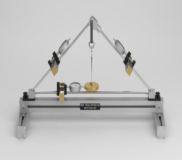
Sci-tech Roof Truss Apparatus Model MT 091 is used to measure the deformation in elements of roof truss. Whenever a load is applied to a roof truss, its members undergo a strain. This unit consists of a base structure which provides the suppor [...]

